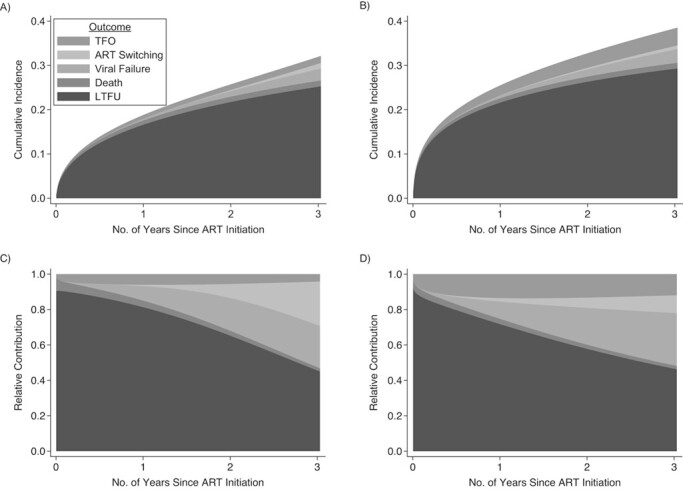Figure 3.

Stacked cause-specific cumulative incidence functions and stacked cause-specific relative contributions to the overall hazard of the outcomes for early versus same-day antiretroviral therapy (ART) under a treat-all policy, Eswatini, 2014–2016. Stacked cause-specific cumulative incidence functions (early ART (A); same-day ART (B)) and stacked cause-specific relative contribution to the overall hazard (early ART (C); same-day ART(D)) of the outcomes of loss to follow-up (LTFU), death, viral failure, treatment switching, and censoring due to transfer out (TFO) for early versus same-day ART. We used the competing risks postestimation command stpm2cif in Stata (StataCorp LP) (59) to estimate the cumulative incidence function for different causes of the outcome (A and B) and the relative contribution to the overall hazard for different causes of the outcome (C and D). The curves are based on a flexible parametric survival model (Royston-Parmar models) (37, 38) using restricted cubic splines. For both interventions, the relative cause-specific contribution of LTFU decreased from approximately 90% at the time of ART initiation to less than half at the end of the observation period (C and D). The cumulative incidence of LTFU was lower for early ART (A) after treatment initiation, but its relative contribution to the outcomes was more pronounced during the first 2 years after treatment initiation when compared with same-day ART (B). Death was rare and similar between both interventions while cumulative transfer out was higher for same-day ART. For both interventions, the relative contribution of viral failure and ART switching to the overall hazard increased rapidly after 6 months since ART initiation (C and D).
